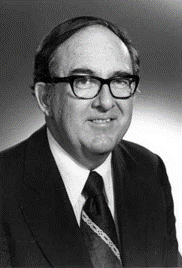About Glenn W. Irwin, Jr.
Glenn W. Irwin, Jr. became the second chancellor of the Indiana University-Purdue University Indianapolis campus in 1973. Prior to that, he had been named dean of the School of Medicine in 1956. As dean, Dr. Irwin led the creation of a statewide medical education program and began the drive to build Indiana University Hospital in June 1965.
Irwin graduated from the School of Medicine in 1944, one of the school's two wartime classes that year, which was the result of the school's effort to produce more doctors to serve the troops injured in the war. After serving at the Schofield Barracks Hospital in Hawaii, he joined the faculty at the School of Medicine in 1950.
Medical education was a key focus for Dr. Irwin and the school during his tenure as dean. In the 1960s, the IU School of Medicine developed the "Indiana Plan," which called for a coordinated statewide system of undergraduate, graduate, and continuing medical education. Conceptualized to create "a medical school without walls, both in space and in time," the system developed under Irwin's direction established seven additional campuses (in addition to Indianapolis and the Bloomington program that started in 1959) where the first two years of medical education were taught in collaboration with basic science faculty at IU Bloomington, Notre Dame, Ball State, Indiana State, the University of Evansville and Purdue University. This was the first comprehensive program to use all of the resources for medical education within an entire state and to develop an integrated system of medical education that served physicians as well as medical students anywhere within that state's borders.
During Dr. Irwin's chancellorship, in partnership with the city of Indianapolis, IUPUI added a sports complex that included a natatorium, an attached physical education building, and a track and field stadium in advance of the National Sports Festival in 1982. To improve access to Wishard Hospital and the campus, Lockefield Gardens was partially razed, and new apartments were added for university students and residents. Work progressed to enhance and expand Riley Hospital for Children (Phase III, 1986) and IU Hospital (Phase II, 1975), and both Regenstrief Institute and the Ronald McDonald House opened, adding research space and a home away from home for families with children being cared for at Riley. Under Dr. Irwin's leadership, IUPUI's visibility and prestige as an academic institution increased dramatically, with important growth in both enrollments and operating budget.
After Dr. Irwin retired from the chancellor's post in 1986, he continued to serve the community as a member of the boards of the Eiteljorg Museum of Western Art and the American Indian, the YMCA of Greater Indianapolis and the Riley Children's Foundation Board of Governors.


